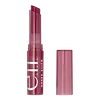What's inside
What's inside
 Key Ingredients
Key Ingredients

 Benefits
Benefits

 Concerns
Concerns

 Ingredients Side-by-side
Ingredients Side-by-side

Tridecyl Trimellitate
EmollientOctyldodecanol
EmollientDiisostearyl Malate
EmollientIsononyl Isononanoate
EmollientPolyglyceryl-2 Isostearate/Dimer Dilinoleate Copolymer
EmollientPentaerythrityl Tetraisostearate
EmollientSynthetic Wax
AbrasiveBis-Diglyceryl Polyacyladipate-2
EmollientHydrogenated Microcrystalline Wax
Emulsion StabilisingTriethylhexanoin
MaskingOzokerite
Emulsion StabilisingLimnanthes Alba Seed Oil
Skin ConditioningHydrogenated Coco-Glycerides
EmollientPhenoxyethanol
PreservativeTocopheryl Acetate
AntioxidantCI 77499
Cosmetic ColorantCI 77491
Cosmetic ColorantCI 15985
Cosmetic ColorantCI 15850
Cosmetic ColorantCI 77891
Cosmetic ColorantTridecyl Trimellitate, Octyldodecanol, Diisostearyl Malate, Isononyl Isononanoate, Polyglyceryl-2 Isostearate/Dimer Dilinoleate Copolymer, Pentaerythrityl Tetraisostearate, Synthetic Wax, Bis-Diglyceryl Polyacyladipate-2, Hydrogenated Microcrystalline Wax, Triethylhexanoin, Ozokerite, Limnanthes Alba Seed Oil, Hydrogenated Coco-Glycerides, Phenoxyethanol, Tocopheryl Acetate, CI 77499, CI 77491, CI 15985, CI 15850, CI 77891
Diisostearyl Malate
EmollientBis-Behenyl/Isostearyl/Phytosteryl Dimer Dilinoleyl Dimer Dilinoleate
EmollientBis-Diglyceryl Polyacyladipate-2
EmollientHydrogenated Polyisobutene
EmollientCeresin
Emulsion StabilisingOctyldodecanol
EmollientSynthetic Wax
AbrasivePentaerythrityl Tetraisostearate
Emollient1,2-Hexanediol
Skin ConditioningDisteardimonium Hectorite
StabilisingSodium Hyaluronate
HumectantPassiflora Edulis Seed Oil
EmollientTheobroma Grandiflorum Seed Butter
Skin ConditioningPalmitoyl Hexapeptide-12
Skin ConditioningParfum
MaskingTocopheryl Acetate
AntioxidantPropylene Carbonate
SolventCaprylic/Capric Triglyceride
MaskingC10-18 Triglycerides
EmollientTriolein
Skin ConditioningStearalkonium Hectorite
Gel FormingGlyceryl Dioleate
EmollientCI 77891
Cosmetic ColorantIron Oxides
CI 15850
Cosmetic ColorantCI 15985
Cosmetic ColorantDiisostearyl Malate, Bis-Behenyl/Isostearyl/Phytosteryl Dimer Dilinoleyl Dimer Dilinoleate, Bis-Diglyceryl Polyacyladipate-2, Hydrogenated Polyisobutene, Ceresin, Octyldodecanol, Synthetic Wax, Pentaerythrityl Tetraisostearate, 1,2-Hexanediol, Disteardimonium Hectorite, Sodium Hyaluronate, Passiflora Edulis Seed Oil, Theobroma Grandiflorum Seed Butter, Palmitoyl Hexapeptide-12, Parfum, Tocopheryl Acetate, Propylene Carbonate, Caprylic/Capric Triglyceride, C10-18 Triglycerides, Triolein, Stearalkonium Hectorite, Glyceryl Dioleate, CI 77891, Iron Oxides, CI 15850, CI 15985
Ingredients Explained
These ingredients are found in both products.
Ingredients higher up in an ingredient list are typically present in a larger amount.
This ingredient is lipid-based synthetic skin-conditioning agent derived from adipic acid and a mixture of fatty acids. It is often called a lanolin substitute.
As an emollient, it helps soften and hydrate the skin. Emollients create a barrier on the skin to trap moisture in.
Due to its fatty acid base, it may not be Malassezia folliculitis safe.
Learn more about Bis-Diglyceryl Polyacyladipate-2Ci 15850 is the pigment color red. It is an azo dye and created synthetically.
Azo dyes need to be thoroughly purified before use. This allows them to be more stable and longer-lasting.
This ingredient is common in foundations, lipsticks, and blushes. This color is described as brown/orangey red.
It has many secondary names such as Red 6 and Red 7. According to a manufacturer, Red 6 usually contains aluminum.
Learn more about CI 15850Ci 15985 is a dye made from petroleum. It is synthetically created and approved by the FDA for use in foods and cosmetics.
The color of this dye is orange/yellow.
This ingredient can be found in makeup, sun care, and skincare.
Learn more about CI 15985Ci 77891 is a white pigment from Titanium dioxide. It is naturally found in minerals such as rutile and ilmenite.
It's main function is to add a white color to cosmetics. It can also be mixed with other colors to create different shades.
Ci 77891 is commonly found in sunscreens due to its ability to block UV rays.
Learn more about CI 77891Diisostearyl Malate is an emollient and most often used in lip products. It comes from isostearyl alcohol, a fatty acid, and malic acid, an AHA.
As an emollient, Diisostearyl Malate helps create a thin film on your skin to trap moisture in. This helps keep your skin soft and smooth.
Octyldodecanol is a fatty alcohol. It is primarily used to enhance the texture of products.
As an emulsifier, Octyldodecanol helps prevent the oils and waters from separating. It also prevents ingredients from creating foam when shaken.
Octyldodecanol is created by reducing fatty acid to an alcohol.
Due to its high molecular weight, it does not get absorbed into the skin.
Learn more about OctyldodecanolPentaerythrityl Tetraisostearate is derived from isostearic acid. It is an emollient and emulsifier.
The highest concentration of this ingredient is found in lipsticks.
This ingredient is minimally water soluble and may not be Malassezia folliculitis, or fungal-acne safe.
Learn more about Pentaerythrityl TetraisostearateSynthetic Wax is created from fossil fuels such as natural gas. It is used to enhance texture, adjust pH, and as an occlusive.
It may also be used as an abrasive ingredient to exfoliate the skin.
Synthetic Wax may not be fungal acne safe.
Learn more about Synthetic WaxTocopheryl Acetate is AKA Vitamin E. It is an antioxidant and protects your skin from free radicals. Free radicals damage the skin by breaking down collagen.
One study found using Tocopheryl Acetate with Vitamin C decreased the number of sunburned cells.
Tocopheryl Acetate is commonly found in both skincare and dietary supplements.
Learn more about Tocopheryl Acetate